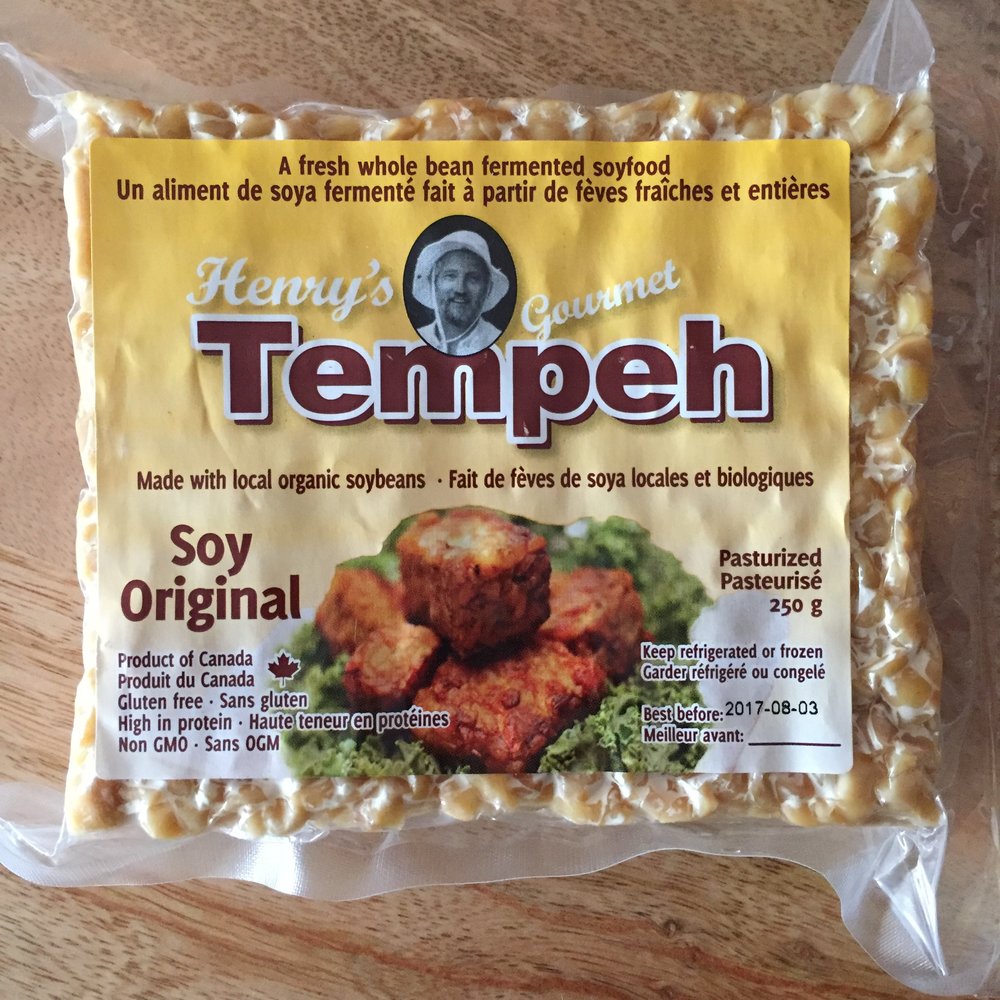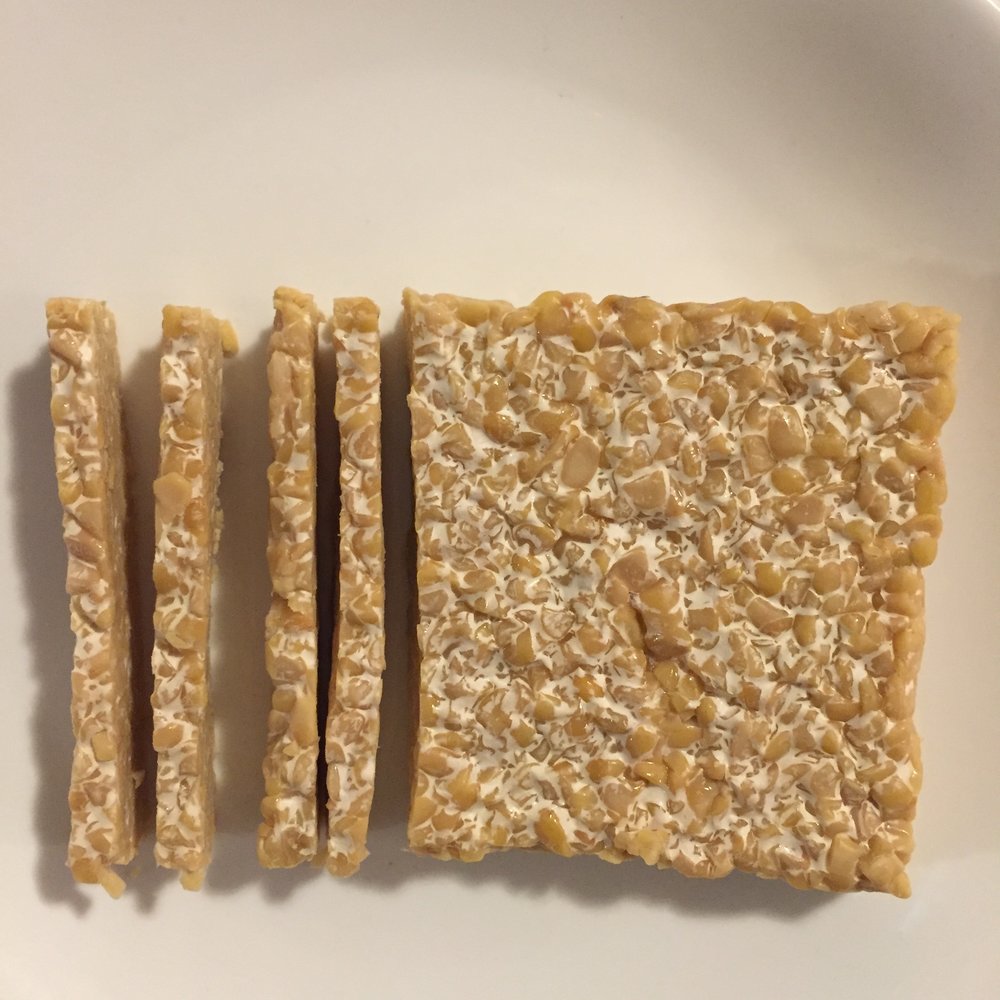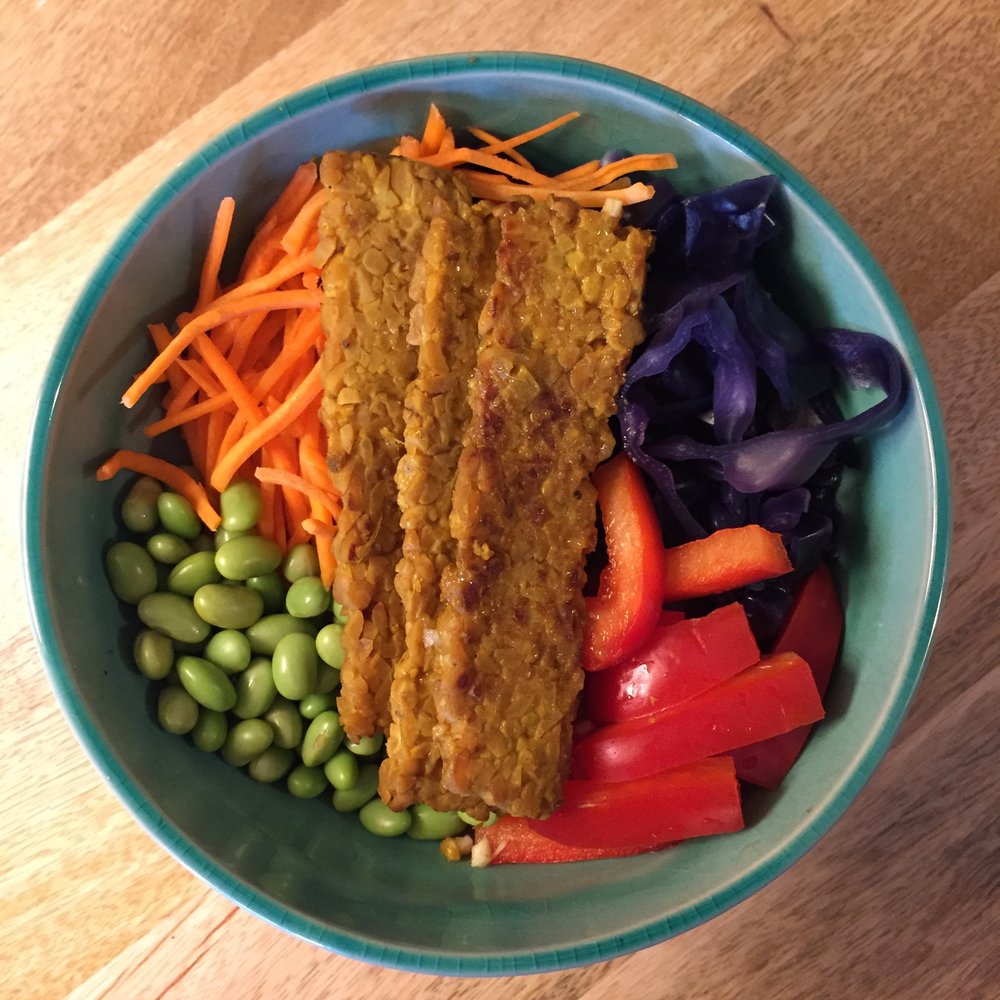Tempeh – Unusual And Undeniably Healthy
What is tempeh?
Organic Tempeh, originating from Indonesia, is vegan, gluten-free, protein-rich, probiotic food made from fresh, organic whole soybeans.
How is it made?
Tempeh is made by first softening whole soybeans by soaking them in water. Next the soybeans are spread onto a tray and inoculated with a beneficial mold culture (Rhizopus oligosporous). It is left to ferment for several days, as the probiotic cultures multiply, the soybeans bind and form a cake, similar to a square veggie patty.
Tempeh is found in the refrigerated section of health food stores, sold in square plastic wrapped packages ¾ inch thick 8 to 12 ounce packages. There are two main brands of tempeh available in Toronto are Noble Bean from Montreal, QU and Henry’s Tempeh from Kitchener, ON.
 Henry’s Tempeh made in Kitchener, Ontario. One of my favourite brands of raw tempeh.
Henry’s Tempeh made in Kitchener, Ontario. One of my favourite brands of raw tempeh.
What does tempeh taste like?
Ho Tempeh has an earthy, nutty taste and a dense, meaty texture that can be used in place of meat for vegetarian dishes . It is quite versatile and takes on flavours nicely. It can be sliced, marinated, grilled, baked or crumbled to resemble ground meats for making vegetarian chili or taco filling.
The Black “spots” on your raw tempeh (and white stuff in-between) are both the beneficial mold cultures which makes tempeh the healthy probiotic food that it is. They are entirely normal and perfectly edible.
 Tempeh is a raw, live, cultured food as evident in the visible mold which happens to be perfectly edible!
Tempeh is a raw, live, cultured food as evident in the visible mold which happens to be perfectly edible!
What are the health benefits of tempeh?
Tempeh is good source of vegan protein. It’s a complete protein meaning that it contains all eight essential amino acids, rare in a plant food. It is also an excellent source of iron and calcium and some minerals such as manganese, copper, selenium, phosphorous magnesium and vitamin B2.
Tempeh contains soy isoflavones that:
- strengthen bones,
- help to ease menopause symptoms,
- reduce risk of coronary heart disease
- Reduce risk of some cancers such as breast cancer.
Probiotics found in tempeh:
- keep the intestines healthy by preventing overgrowth of bad bacteria,
- reduce inflammation,
- prevents constipation
- synthesize vitamin K, folic Acid, vitamin B2 and B12
- and supports immunity!
How is tempeh different from tofu? Which one is healthier?
While both originate from soybeans, there is a clear winner when it comes to health and nutritional benefits.
Tempeh is made from the actual soybeans while tofu is made by coagulating soymilk, a process which makes tofu less of a whole food compared to tempeh. Tempeh is a fermented soy food, tofu is an unfermented soy food, this makes all the difference to their respective health attributes. The fermentation process of making tempeh predigests the soybeans, releasing enzymes and nutrients which makes tempeh more nutritious and easy to digest compared to other soy products, like tofu and soymilk.
Unfermented soy such as tofu contains “antinutrients” — compounds that can interfere with the body’s absorption of nutrients. Phytic acid found in tofu, blocks the body’s ability to absorb calcium, copper, magnesium, iron and zinc.
Another anti-nutrient in tofu known as trypsin inhibitors, disrupts the body’s digestion of proteins. In addition, unfermented soy contains a compounds known as goitrogens, which inhibit the function of the thyroid, a vital gland responsible for regulating many bodily processes including regulating cholesterol, metabolism and mood.
In contrast the natural fermentation of tempeh helps to break down the phytates and other antinutrients found in soy, making its proteins more digestible, and negating many of its otherwise harmful effects.
Below are instructions on how to prepare tempeh. You could marinate tempeh straight out of the package but I find steaming or boiling it for 5 minutes or so before marinating mellows the earthy taste, and also helps the marinade absorb more into the tempeh.
How to Prepare Tempeh
1. Steam. Tempeh tastes better if it’s steamed first. Place sliced tempeh in a saucepan and cover with water or vegetable broth. Bring liquid to a boil, reduce heat, and simmer for a 5 minutes. Then remove the tempeh and proceed with marinating, grilling, baking, or otherwise seasoning and cooking it.
TIP: cutting Tempeh into thin slices (as shown in the picture above), helps marinade absorb more thoroughly into tempeh, resulting in better flavour!
2. Marinate. Tempeh has a rather earthy flavour on its own, not everyone finds it pleasing. Like tofu, tempeh takes well to marinating. Good tempeh marinade ingredients include soy sauce, vinegar, citrus juice, coconut milk, peanut butter, ginger, spices, or sweeteners like maple syrup, agave nectar or honey. Even a quick coat of soy sauce and a few other seasonings like ginger and garlic significantly improves the flavour.
3. Easy Tempeh Recipe. Cut an 8 ounce block of tempeh into thin slices of less than 1/4 inch. (The thinner the easier marinade absorbs, the tastier!) Marinate for 20 minutes in a mixture of Tamari sauce (Japanese gluten-free soy sauce), rice wine vinegar (1 tablespoon), sesame oil (1 teaspoon), minced garlic (1-2 cloves) and minced ginger. Pan-fry over medium heat until golden brown and crispy. Alternatively lay slices in a single layer with marinade in an oven proof baking dish and bake at 350 degrees for 30 minutes.
4. Enjoy Cooked Tempeh with rice or quinoa and vegetables or/ pair with a salad.
 Orange Maple Tempeh (see June blog for recipe) on brown rice with edamame, red peppers, purple cabbage and shredded carrots
Orange Maple Tempeh (see June blog for recipe) on brown rice with edamame, red peppers, purple cabbage and shredded carrots
